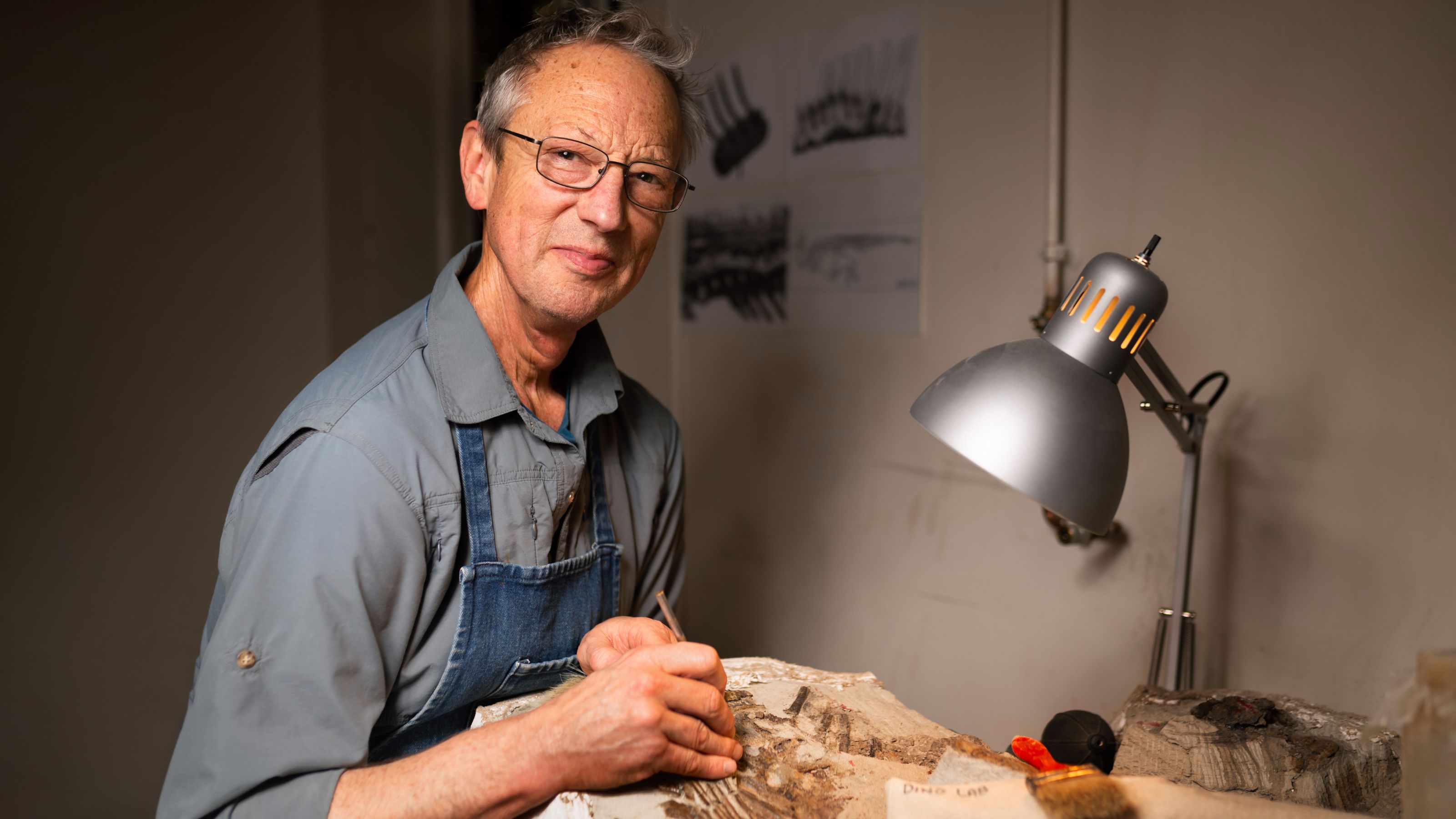Have you met Clive Coy, Chief Technician in the Laboratory for Vertebrate Palaeontology in the Department of Biological Sciences, Faculty of Science? Spend a few minutes getting to know him better.
What is your first U of A memory?
Circa 1975-76, a high school friend’s father worked as a night watchman on campus, and we would come by bus to bring his dinner. Some evenings we played ping-pong against all comers at the Students Union. If we stayed late we warmed our hot dogs and burgers in the early model microwaves available there. It was my first time seeing or using one of those, as yet uncommon, massive machines. It felt right out of Star Trek. I distinctly remember our food always tasted slightly metallic.
What’s something your coworkers don’t know about you?
In early 2019 I was diagnosed with stage 4 oropharyngeal cancer, an advanced squamous cell carcinoma of the head and neck caused by the human papilloma virus (HPV) which is seen more often in men. It required extensive intervention involving 22 hours of surgery, 30 rounds of radiation and 3 doses of toxic chemo drug. A devastating experience that involved the removal of portions of my tongue and surrounding tissues and muscle grafts. I had to learn how to swallow and speak again. Changes to my neck and shoulder muscles left me unable to lift my arms or sit upright for multiple months. I am grateful to my partner for her advocating and endless care when I could not, or had lost the will to. Remarkable teams at the University of Alberta Hospital, the Cross Cancer Institute and the Alberta Cancer Exercise (ACE) study at the University of Alberta’s Cancer Rehabilitation Clinic were all involved in my long journey.
You can read an excellent Folio article about this type of cancer.
What’s your favourite distraction?
Researching late nineteenth and early twentieth century exploration in northern China and Mongolia, particularly those under the leadership of the American Naturalist Roy Chapman Andrews (1884-1960) during the 1920s. My search for original source materials such as letters and photographs has taken me on a fascinating journey from auction houses to boardrooms and into the kitchens and living rooms of surviving expedition members and their families, as well as multiple professional trips to Mongolia.
If you were enrolling in one course, program or degree right now, what would it be?
A Master of Fine Arts program. Drawing, painting, sculpting and print making are areas of creative expression I want to nurture more as part of my life journey. I am an enthusiast and collector of Japanese woodblock prints and have taught myself how to make simple linocut prints as a way to a greater appreciation of the challenging work of creating these intricate Ukiyo-e, or images of the floating world.
What’s a weird pet peeve you have?
I cannot abide self-appointed-self-anointed “experts”, “influencers" and “trend-setters”.
You can invite anyone — alive or dead, real or fictional — to dinner. Who would it be?
I would enjoy an evening of great food and drink with the French archaeologist, explorer, author and early women’s rights activist Jane Dieulafoy (1851-1916). A fascinating personality who as a young bride dressed convincingly as a soldier and rode with her husband into the front lines of the Franco-Prussian War of 1870, living under harsh and dangerous conditions while never revealing her gender. One of the first modern European women to always wear men’s clothing, Dieulafoy spent her life advocating for women dressing how they wanted and for meaningful lives beyond raising children. Her excavations of and publications related to the ancient city of Susa (biblical Shushan) on the edge of the Iranian plateau, are among the earliest works of scientific Archaeological documentation and not looting treasure hunts typical of the era.
If you could see any live performance tomorrow, what would it be?
The English New Wave group Japan (1974-1982). Their albums Gentlemen Take Polaroids (1980) and Tin Drum (1981) are still on regular rotation in my life. Their electronic world-music influenced sound was crucial to my dealing with the cultural isolation I experienced living in a small town during the early 1980s.
What advice would you give your 18-year-old self?
Don’t take things too seriously. You are at the threshold of endless possibilities, and much of what you worry about today will come to naught. What seemed impossible will one day be your everyday reality.
What’s one thing you can’t live without?
Oxygen. After that, good coffee.
What three words describe your U of A experience?
Challenging, Humbling, Rewarding.

About Clive
Clive Coy is Chief Technician in the Laboratory for Vertebrate Palaeontology and supervises Dino Lab, part of the Dinosaur Palaeobiology program. Clive has discovered, collected and prepared a wide variety of vertebrate fossils for research and exhibition in Argentina, Canada, France, Japan, Korea, Mongolia and Norway. He enjoys the ‘dirty-hands’ aspect of this work, as well as the exchange of ideas with scientists, students and the public. Clive was a founding team member of The Royal Tyrrell Museum of Paleontology, and has helped found new fossil preparation facilities in Japan, Korea, Mongolia, as well as here at the University of Alberta. He is a founding member of The Roy Chapman Andrews Society (Beloit) and a member of The Explorers Club (New York).
